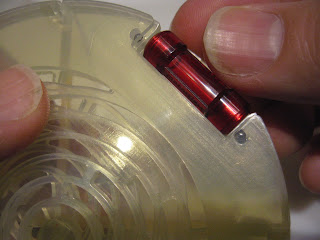The SD300 can make good simulations of laser-cut parts, given adequate model data. I created accurate simulations of laser-cut models by first modeling a sheet about the anticipated thickness of the part, about 3.0 mm to simulate the typical "eighth inch acrylic" (which usually runs a tad thin). To simulate a laser's cutting behavior I cut the outlines using a "thin wall cut" with a 2 degree draft angle.
Models were easy to clean because the sheet-like design meant there weren't any overhangs, undercuts, or loose ends to deal with. It was easy to stab leftover support material and peel it away from both sides of each finished piece.
I also designed a 2-piece base, shown upside-down here, on which the maze layers are stacked. The base aligns the maze pieces and holds them together.
The magnetic wand can be stored in a compartment at the top edge of the maze, and it's held in place because the magnets in the wand are attracted to steel beads embedded inside the model.
Moiré Maze was inspired by Boston Subway, Oskar van Deventer's design for IPP26 shown at left in the picture. Boston Subway has layers of criss-crossing channels built from laser-cut acrylic, and the goal was to guide a little magnet from "work" to "home" using a magnetic wand. Moiré Maze substitutes ring-shaped channels for the straight ones, and thereby creates a visual hiding place for its solution even though it's entirely transparent!






